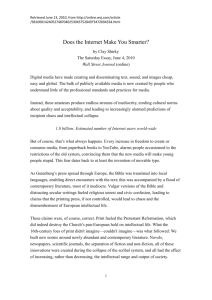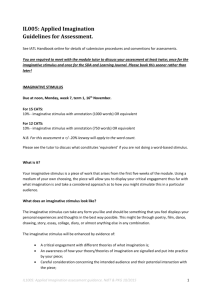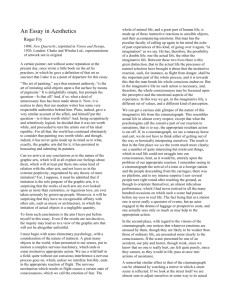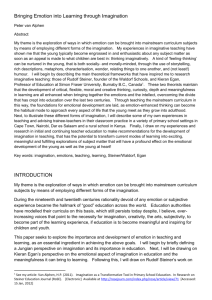Tim - IERG
advertisement
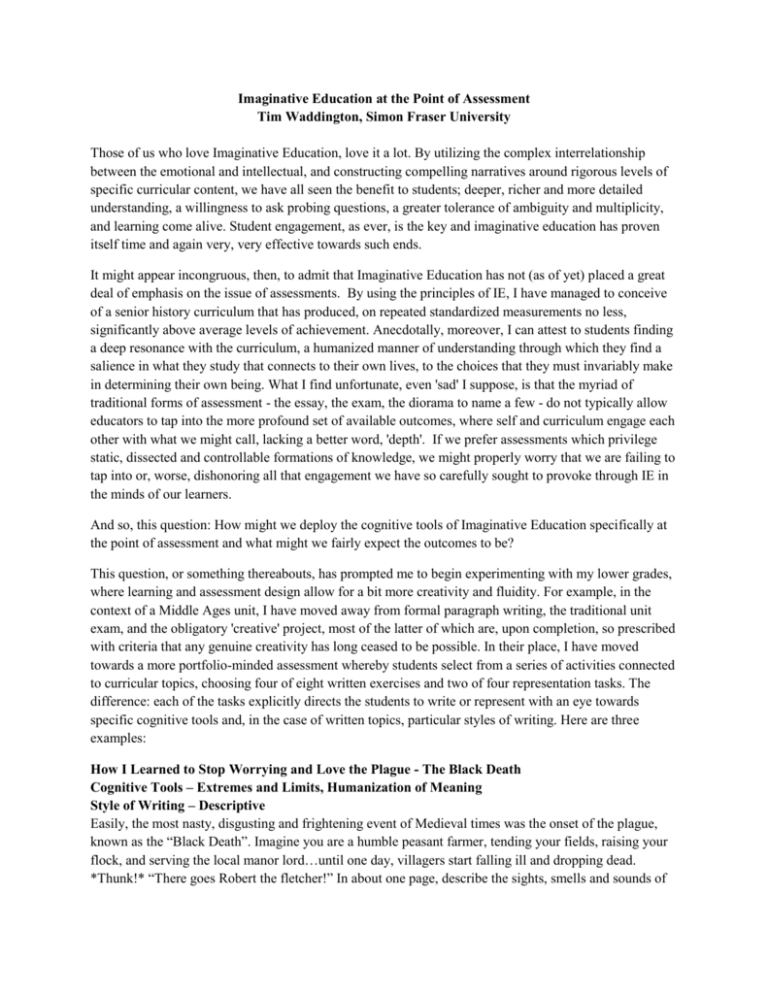
Imaginative Education at the Point of Assessment Tim Waddington, Simon Fraser University Those of us who love Imaginative Education, love it a lot. By utilizing the complex interrelationship between the emotional and intellectual, and constructing compelling narratives around rigorous levels of specific curricular content, we have all seen the benefit to students; deeper, richer and more detailed understanding, a willingness to ask probing questions, a greater tolerance of ambiguity and multiplicity, and learning come alive. Student engagement, as ever, is the key and imaginative education has proven itself time and again very, very effective towards such ends. It might appear incongruous, then, to admit that Imaginative Education has not (as of yet) placed a great deal of emphasis on the issue of assessments. By using the principles of IE, I have managed to conceive of a senior history curriculum that has produced, on repeated standardized measurements no less, significantly above average levels of achievement. Anecdotally, moreover, I can attest to students finding a deep resonance with the curriculum, a humanized manner of understanding through which they find a salience in what they study that connects to their own lives, to the choices that they must invariably make in determining their own being. What I find unfortunate, even 'sad' I suppose, is that the myriad of traditional forms of assessment - the essay, the exam, the diorama to name a few - do not typically allow educators to tap into the more profound set of available outcomes, where self and curriculum engage each other with what we might call, lacking a better word, 'depth'. If we prefer assessments which privilege static, dissected and controllable formations of knowledge, we might properly worry that we are failing to tap into or, worse, dishonoring all that engagement we have so carefully sought to provoke through IE in the minds of our learners. And so, this question: How might we deploy the cognitive tools of Imaginative Education specifically at the point of assessment and what might we fairly expect the outcomes to be? This question, or something thereabouts, has prompted me to begin experimenting with my lower grades, where learning and assessment design allow for a bit more creativity and fluidity. For example, in the context of a Middle Ages unit, I have moved away from formal paragraph writing, the traditional unit exam, and the obligatory 'creative' project, most of the latter of which are, upon completion, so prescribed with criteria that any genuine creativity has long ceased to be possible. In their place, I have moved towards a more portfolio-minded assessment whereby students select from a series of activities connected to curricular topics, choosing four of eight written exercises and two of four representation tasks. The difference: each of the tasks explicitly directs the students to write or represent with an eye towards specific cognitive tools and, in the case of written topics, particular styles of writing. Here are three examples: How I Learned to Stop Worrying and Love the Plague - The Black Death Cognitive Tools – Extremes and Limits, Humanization of Meaning Style of Writing – Descriptive Easily, the most nasty, disgusting and frightening event of Medieval times was the onset of the plague, known as the “Black Death”. Imagine you are a humble peasant farmer, tending your fields, raising your flock, and serving the local manor lord…until one day, villagers start falling ill and dropping dead. *Thunk!* “There goes Robert the fletcher!” In about one page, describe the sights, smells and sounds of the Black Death, and what you feel about all the horrifying things you are experiencing. The best work here will purposefully include the most extreme, icky, nauseating, putrid, foul…well, you get the picture. Be sure to find or create images that demonstrate what you want to describe. All Ashore that’s Goin’ Ashore! The Battle of Hastings Cognitive Tools – Heroic Quality (Leadership) and the Literate Eye Style of Writing – Persuasive Here, your task is to write about one page that praises the leadership qualities of the handsome, the suave, the debonair William the Conqueror as he led the Norman invasion and established the feudal system. Show your knowledge of the causes and events of the Battle of Hastings and explain both why the feudal system was established and how it worked. Your purpose is to heap praise on William, who is the most charming and manly of all men, to make him sound like the greatest, most intelligent and heroic leader that ever was. Be sure to include some form of graphic: a map, flowchart or other picture. Boneheads, Hare Brains and other Dullards – Kings and Queens of the Middle Ages Cognitive Tools – Binary Opposites, Collections Style of Writing – Descriptive, Expository Let’s admit it, absolute power is a pretty cool thing…if you’re the one that has it. Medieval times were filled with the most motley crew of characters you could possibly imagine. Starting a war that lasts 97 years? Check! Threatening the Pope with an invasion of Rome because you want a divorce? You bet! Marrying your brother’s widow after bumping him off? Yup! Got that one too! Your task here is to describe, in about one page, who you think are the four or five most interesting of all the medieval monarchs. In your work, try to find the biggest heroes, villains, numbskulls and crooks who ever tarnished the crown. It might be a good idea to find portraits of the rulers so we all know exactly who to throw darts at! I think it's important to notice that there isn't anything particularly revolutionary here. The Black Death, for example, is a prime opportunity for students to write in descriptive styles, and the cognitive tool of extremes and limits alongside the humanization of meaning appear well suited, even motivational, towards the end of pushing learners into deep contact with material being studied. Likewise, by suggesting that the royals of medieval England were of a uniquely iniquitous disposition, we can invite the children's imaginations to engage with the material through particularly engaging lenses. The greater the color, the better. We know these things instinctively as teachers, so it's really a matter of shaping the intellectual and productive space in which the children operate so as to promote engagement, imagination and creative modes of expression. What's more is the recognition that nothing, other than a dry, alienating and ultimately faulty claim to objectivity is lost in assessing learning in this manner. In order to write something of merit, students will still need to perform quality research and work through the processes of writing, the skills of which can also be taught. Students will need to know a lot and will be far more likely to engage in a deeper appreciation of role, audience and process of writing, asking questions such as 'have I really brought out the grossness and suffering of this?' or 'how could I write this so that it's even more funny?'. Surely, such self-talk is in service of a brand of literacy which is fluid, flexible and appreciative in addition to being 'grammatically sound' and 'well proofread'. While one could go on for a while offering such benefits, it might in the interests of brevity be enough to say that the material we have to teach is engaging enough in its own right and doesn't particularly benefit from our overzealous attempts to boil it down into inert, 'knowable', and thereby testable bits of memory. If we want children to know and love what we offer them, we need to respect its emotional as well as intellectual quotient. We need to engage the imagination. Ultimately, few things are quite as frustrating as pouring one's heart and soul into hopefully well-crafted lessons and then spending hours into the evening, sequestered away from friends and family, marking tests and essays only to find two weeks later that students have long-since forgotten most of which we presumed we had 'taught' and they had 'learned'. The truth of the matter is that we do not enjoy nearly as much control over such outcomes as we would like to assume. By deploying the cognitive tools at the point of assessment, we might set the students into an intellectual and productive space which allows just enough room for imagination and creativity to gain traction while maintaining a rigorous demand for detailed and specific knowledge of historical contexts. The potential of Imaginative Education, as I have attempted to depict it here, is its emphasis on the emotional and intellectual aspects of knowing in their coincidence. We cannot, and probably should not, attempt to control every outcome in our classrooms, for such results in deadened, sterile environments and the most shallow of learning gains. To the extent that all learning is to a greater or lesser extent languaged, it behooves us to construct a space around students so as to subtly direct them towards multiple expressions of literacy and to plain old love language. In using the cognitive tools at the point of assessment, we might at least be consistent between the profession of our aims and our measurements. Engagement, as ever, remains at the center. Tim Waddington is proud to be a public school teacher in Surrey BC, specializing in History, Giftedness, and the Humanities. He began his career in 1996, after several frustrated attempts at real jobs such as warehouseman, inventor and left-handed sculpting. Tim holds degrees in Education and Leadership and is actively procrastinating his way through a Doctoral Thesis on Existentialism at Simon Fraser University.






